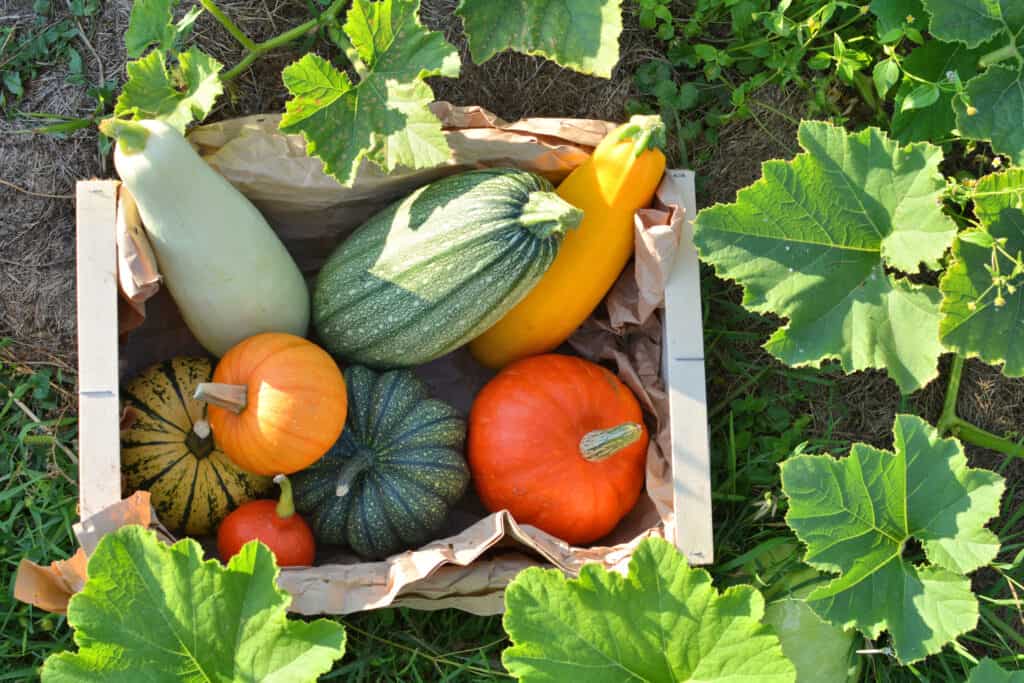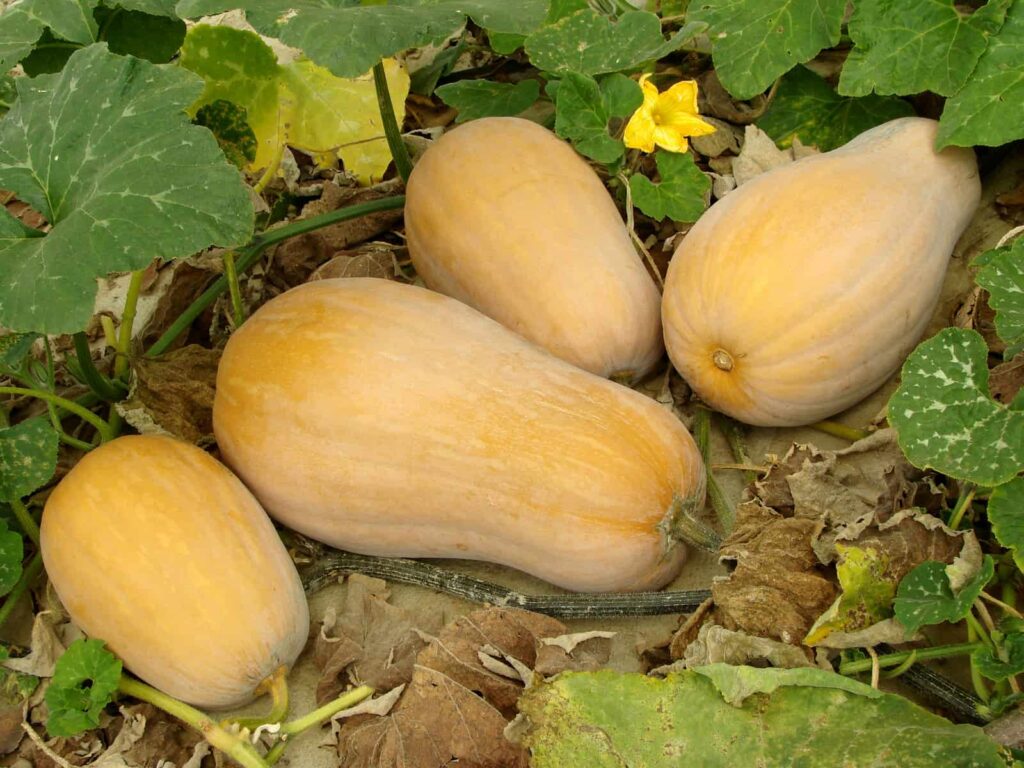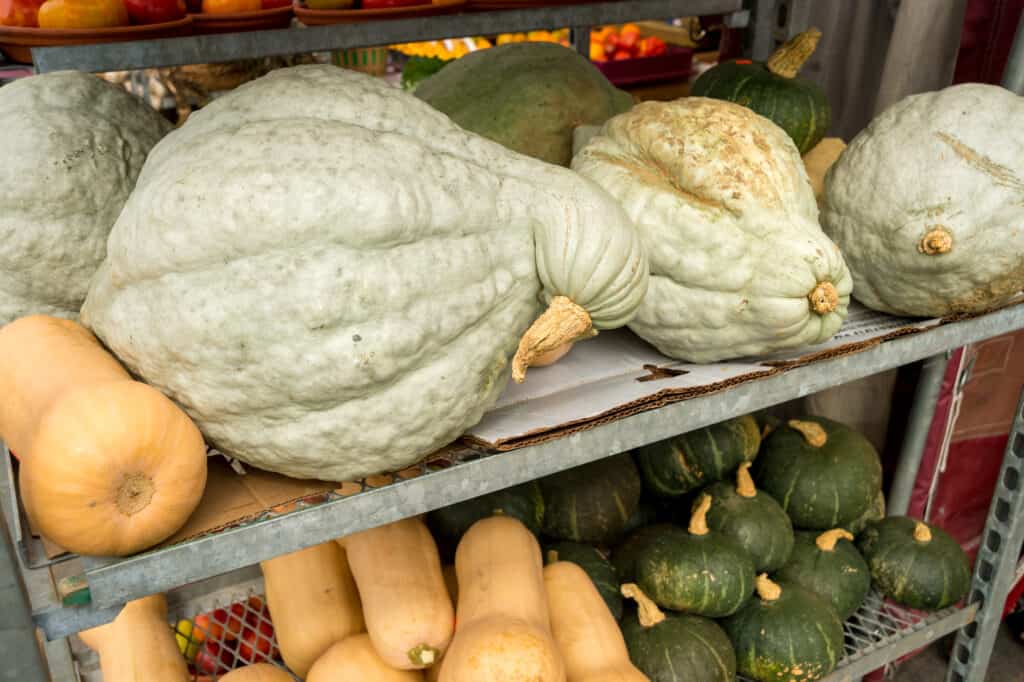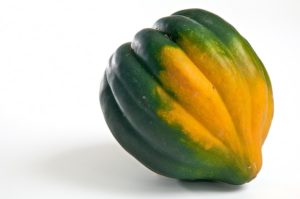Harvest winter squashes when they are mature. Winter squash is mature when its rind cannot be scratched with a thumbnail.
Winter squashes include Acorn, Butternut, Hubbard, Banana, Buttercup, Spaghetti, and pumpkins.

Winter squash refers to squash planted in spring, grown in summer, harvested in fall, and stored for winter use. Winter squashes require more days to reach maturity than summer squash. Winter squashes store well while summer squashes do not.
When to harvest winter squash
- Winter squash is ready for harvest when the rind is hard and is difficult to scratch with a fingernail. The skin of mature squash will be dull and dry looking; immature squash will have bright skin with a sheen.
- Harvest winter squash before nighttime temperatures dip into the 40°s F and before the first frost.
- Squash harvested after frost will be sweeter but will not store as long as squash harvested before frost.

How to harvest winter squash
- Cut the squash away from the vine cleanly with a pruner or lopper.
- Leave a 2- to 4-inch stem to cure with the squash. Ripping fruit from the vine can leave a wound that can turn to rot.
How to prepare winter squash for curing
- Squash with a broken or loose stem will not store well. The exception is Hubbard-type squash which stores best with the stem completely removed.
- Clean squash for storage with a dry towel; remove dirt and debris and any blossom that remains on the squash.
- Don’t use water to clean the skin of the squash. Keep the squash dry. Do not handle or harvest wet fruit.
- Cure and store only blemish-free squash; do not cure squash that is bruised or punctured or deeply cut. Curing can help heal minor cuts and scratches.
- Slightly immature squash can be cured but it best to harvest and cure mature squash.

How to cure winter squash
- Winter squash when harvested must be prepared for storage. Preparation is simple—called curing—and requires little effort. Curing is essential for the long storage of winter squash.
- Curing—a form of drying—allows excess moisture in the squash to simply evaporate and slows the fruit’s respiration rate; both are important for long-term storage.
- As water evaporates from the squash, natural sugars are concentrated and the squash becomes sweeter tasting.
- Curing also causes the skin or rind of winter squash to become harder. Hard skin slows respiration, helps the stored squash resist rot and collapse, and allows long storage.
- Cure squash and pumpkins for 10 days at temperatures between 80°F and 85°F and relative humidity of 80 to 85 percent.
- Curing winter squash requires about 10 to 14 days of simply letting the squash sit in a warm place with good air circulation. To cure winter squash set it on an elevated rack or mesh frame—chicken wire stretched across a frame or a window screen will do—and let the air circulate. Keep the squash dry during curing.
- Winter squashes that require curing include Blue Hubbard, Buttercup, Butternut, and Spaghetti. Acorn squash is a winter squash that should not be cured; curing Acorn squash will reduce its storage life and quality.
- If squash can not be cured outdoors, use a small cabinet with a thermostatically controlled electric heater or set squash in a warm shed or garage with a small fan to maintain good air circulation.
How to store winter squash
- Store winter squash in a cool, dry place; store winter squash at 50° to 55° F with a relative humidity of 50 to 70 percent—higher humidity can result in rot.
- Store cured squash on a shelf or rack, not on the floor.
- Keep the skins of cured squash dry to prevent the growth of fungi and bacteria.
- Do not store squash near apples, pears, or other ripening fruit. Ethylene gas released from ripening fruit can cause the squash to yellow and eventually rot.
- Wiping the skin of winter squash for storage with 1 part household bleach in 10 parts of water can slow the growth of microorganisms that can cause rot.
- Inspect stored winter squash weekly. Squash that starts to spot should be moved away from other stored squash and used as soon as possible. Skin spotting can be a sign of rot setting in.

Storage life of winter squashes
The storage life of winter squashes is:
- Acorn and spaghetti squash, about 1 month. The skin of Acorn-type squashes stored longer than 1 to 2 months will become yellow and the flesh stringy.
- Butternut, 2 to 3 months.
- Hubbard types, 3 to 6 months.
- Banana, 3 to 6 months.
- Buttercup or turban types, 3 to 6 months.
- Jack O’ Lantern and Connecticut field pumpkins can be stored 2 to 3 months.
Squash articles at Harvest to Table:
How to Grow Summer and Winter Squash
How to Plant and Grow Pumpkins
How to Harvest and Store Summer Squash
How to Harvest, Cure, and Store Winter Squash
How to Harvest and Store Pumpkins
Eight Ways to Cook and Serve Summer Squash
Seven Ways to Cook and Serve Winter Squash
How to Make Creamy Pumpkin Soup
How to Cook and Serve Squash Blossoms
Squash Growing Problems: Troubleshooting
Squash Vine Borer Organic Pest Control
Squash Bug Organic Pest Control
Corn, Beans, and Squash: The Three Sisters
Garden Planning Books at Amazon:
- Vegetable Garden Almanac & Planner
- Kitchen Garden Grower’s Guide Vegetable Encyclopedia
- Vegetable Garden Grower’s Guide
- Tomato Grower’s Answer Book
More harvest tips:
Learn when and how to harvest your favorite vegetables for the best flavor and texture. Get storage tips for each crop. Click on the vegetable you are growing below.
- Artichoke
- Arugula
- Asparagus
- Beans
- Beets
- Broccoli
- Brussels Sprouts
- Cabbage
- Cantaloupe — Melons
- Carrots
- Cauliflower
- Celery
- Chard
- Collards
- Corn, Sweet
- Cucumbers
- Eggplant
- Endive and Escarole
- Garlic
- Jerusalem Artichoke
- Kale
- Kohlrabi
- Leeks
- Lettuce
- Melons
- Okra
- Onions
- Parsnips
- Peas
- Peppers
- Potatoes
- Pumpkins
- Radicchio
- Rhubarb
- Rutabaga
- Spinach
- Squash, Summer
- Squash, Winter
- Sunchokes
- Sweet Potato
- Swiss Chard
- Tomatillo
- Tomatoes
- Turnips
- Watermelon















